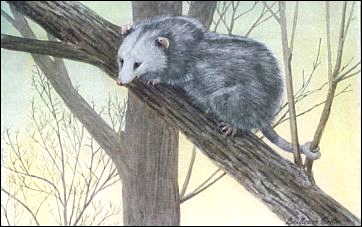

Although mostly excluded from the northern parts of the Chihuahuan Desert, the Virginia Opossum has been introduced into the El Paso area. It is one of our strangest North American mammals. Why strange? Because opossums are marsupials, more akin to kangaroos and koala bears than to our ordinary run of mammals. Most people associate an abdominal pouch with marsupials (and, in fact, the name of the group comes from the Latin word for pouch: marsupium).
However, that's not really what makes them strange from our
viewpoint. Unlike other local mammals, opossum young are born when they are little more
than embryos, and only about 12 and a half days after fertilization occurs. Now this
may sound like heaven to a human mother who struggles through some 9 months of
pregnancy—but don't be too quick to judge. The new-born opossum uses its only
well-developed parts, its forelimbs, to climb to the pouch and then spends the next
couple of months attached to a nipple—along with its 10 or so siblings. Care to rethink
what sounds like heaven?

Contributor: Arthur H. Harris, Laboratory for Environmental Biology, Centennial Museum, University of Texas at El Paso.
Desert Diary is a joint production of the Centennial Museum and KTEP National Public Radio at the University of Texas at El Paso.

Opossum. Painting by Louis Agassiz Fuertes. After Nelson, 1918.
Nelson, E. W. 1918. Wild animals of North America. National Geographic Society, Washington, D.C. 612 pp.